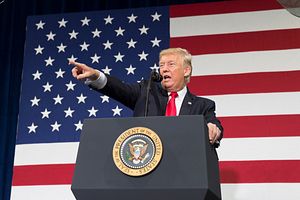With seemingly little warning or planning, U.S. President Donald Trump has decided to accept an invitation from Kim Jong-un for a summit later this year. The meeting will be the first U.S.-North Korea summit. As the administration prepares, it should be prepared to at least answer or think about the following questions.
1. What is the final objective of the talks? South Korean National Security Adviser Chun Eui-yong has said it is to “achieve permanent denuclearization.” Is Trump ready to accept anything less than that? What happens if, upon his arrival at the meeting venue, Kim Jong-un is unwilling to discuss his nuclear arsenal at all?
2. What will be the venue be? The most likely candidate is Panmunjom, south of the Military Demarcation Line between the two Koreas. Kim Jong-un will test this venue out with South Korean President Moon Jae-in in late April. Trump should not be willing to sweeten the already-sweet concession of a summit by traveling to North Korean soil to see Kim Jong-un — a move that could double down on the propaganda benefits for Kim. If Kim refuses to leave North Korea again for the summit, what will the Trump administration propose?
3. What assurances or pre-summit concessions will the administration ask of Pyongyang? South Korea has shuttled between the two sides so far, but presumably there will be a need for direct communication before a summit. A summit in itself represents an important U.S. concession to a longstanding North Korean demand without any reciprocal concession from Pyongyang of a similar magnitude. Will Trump’s side request, for example, the release of the three American citizens who remain in North Korean custody?
4. Kim Jong-un has presumably agreed to freeze ballistic missile and nuclear testing in the run-up to talks and through the talks. But as the U.S.-South Korea Foal Eagle drills kick off soon, North Korea will conduct its own readiness exercises. Even if Kim withholds from testing long-range ballistic missiles, where would the United States draw the line? For instance, can rocket artillery, including multiple launch rocket systems like the KN09, be used during these drills? What about North Korea’s Toksa, or the new solid-fuel short-range ballistic missile it showed during its recent parade? These technical details matter. A misunderstanding between the two sides over whether satellite launches were covered under the February 2012 “Leap Day” agreement resulted in the deal falling apart. Both sides must avoid a similar breakdown today.
5. Assuming the Trump administration won’t allow the perfect to become the enemy of the good, what are the priorities of what it will seek from North Korea short of denuclearization? Here, the administration could seek to establish military-to-military deconfliction channels and a verifiable long-term freeze.
6. How will the administration coordinate with China? Trump will meet Kim Jong-un before Xi Jinping ever will if this summit goes through. China has welcomed the inter-Korean thaw and the U.S.-North Korean summit. Will the Trump administration seek continued coordination with Beijing? Trump reportedly called Chinese President Xi Jinping after accepting Kim Jong-un’s invitation. What role can Beijing play in the upcoming talks?
7. What will the Trump administration’s opening offer be for North Korea? The administration has said it is not looking to enter “negotiations,” but it must be ready for the prospect of a conversation about denuclearization — be that caps on Kim’s weapons or that long-hallowed goal of complete, verifiable, and irreversible disarmament. When negotiations with Iran began for what eventually became the Joint Comprehensive Plan of Action, the United States came to the table with a prepared list of ideal concessions. The Trump administration must do the same on North Korea, even if this task appears to be difficult in the limited amount of time available before the May 2018 summit. (The dearth of expertise and experienced personnel in this administration will also make this a challenge.)
8. How will the administration handle a complete failure of diplomacy? This could be the failure of a summit to actually materialize by May, or a debacle at the summit, with Kim potentially embarrassing Trump? The worst-case scenario is easy to visualize: Trump, enraged at his ally for setting up the summit and at Kim for embarrassing him, turns to unilateral military force, precipitating the very catastrophe South Korean President Moon Jae-in has sought to avoid with this rapprochement. Will the administration take that outcome for granted or work to save face? Will there be space for a face-saving way out for both Kim Jong-un and Trump if the summit falls flat?
This is far from an exhaustive list of considerations that must be taken up by the Trump administration at the highest levels before the May summit with Kim Jong-un. Given the accounts of Trump’s response to Chung Eui-yong’s announcement of Kim Jong-un’s invitation — an eager and immediate “Yes!” — it is far from clear that the administration is prepared for the road it’s about to head down. Previous U.S. administrations learned the hard way why diplomacy with North Korea is so difficult. I don’t expect Trump to fare much better.

































